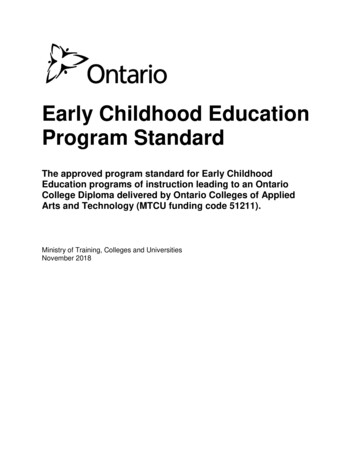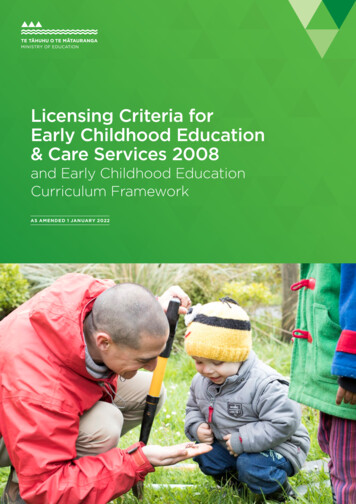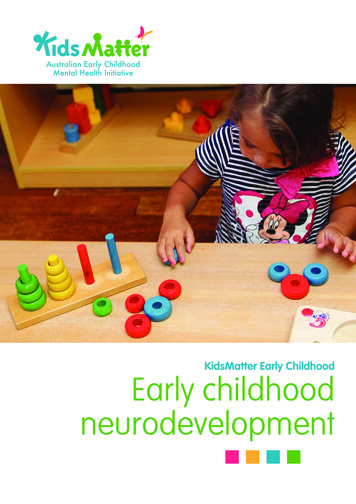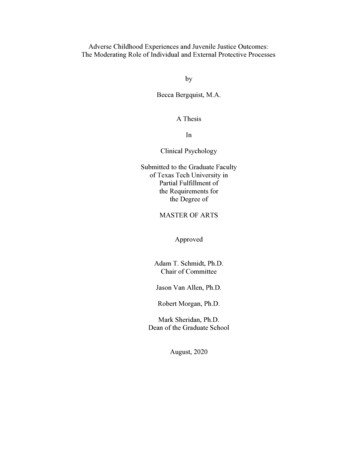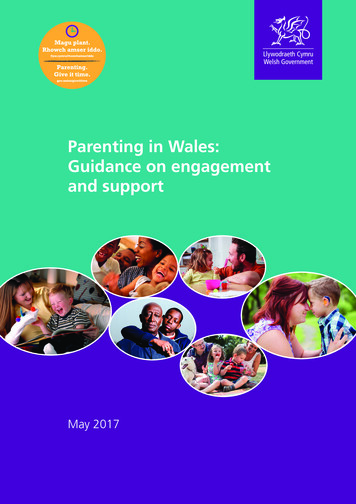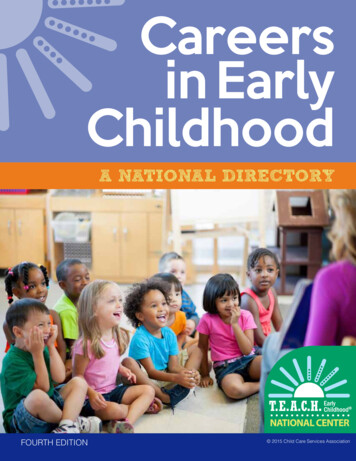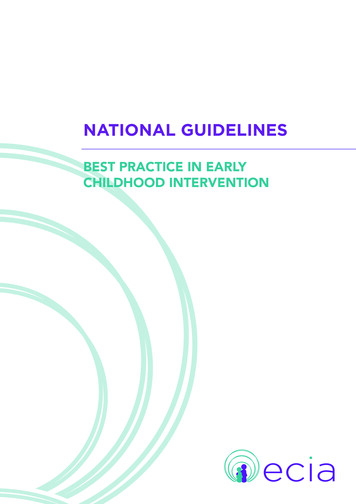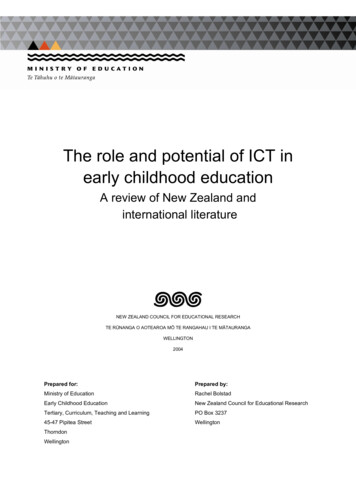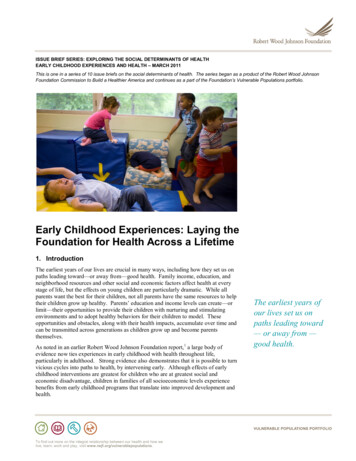
Transcription
ISSUE BRIEF SERIES: EXPLORING THE SOCIAL DETERMINANTS OF HEALTHEARLY CHILDHOOD EXPERIENCES AND HEALTH – MARCH 2011This is one in a series of 10 issue briefs on the social determinants of health. The series began as a product of the Robert Wood JohnsonFoundation Commission to Build a Healthier America and continues as a part of the Foundation’s Vulnerable Populations portfolio.Early Childhood Experiences: Laying theFoundation for Health Across a Lifetime1. IntroductionThe earliest years of our lives are crucial in many ways, including how they set us onpaths leading toward—or away from—good health. Family income, education, andneighborhood resources and other social and economic factors affect health at everystage of life, but the effects on young children are particularly dramatic. While allparents want the best for their children, not all parents have the same resources to helptheir children grow up healthy. Parents’ education and income levels can create—orlimit—their opportunities to provide their children with nurturing and stimulatingenvironments and to adopt healthy behaviors for their children to model. Theseopportunities and obstacles, along with their health impacts, accumulate over time andcan be transmitted across generations as children grow up and become parentsthemselves.As noted in an earlier Robert Wood Johnson Foundation report,1 a large body ofevidence now ties experiences in early childhood with health throughout life,particularly in adulthood. Strong evidence also demonstrates that it is possible to turnvicious cycles into paths to health, by intervening early. Although effects of earlychildhood interventions are greatest for children who are at greatest social andeconomic disadvantage, children in families of all socioeconomic levels experiencebenefits from early childhood programs that translate into improved development andhealth.To find out more on the integral relationship between our health and how welive, learn, work and play, visit www.rwjf.org/vulnerablepopulations.The earliest years ofour lives set us onpaths leading toward— or away from —good health.
Figure 1. A cycle of opportunity orobstacles. At every stage of our lives,social advantage—or disadvantage—islinked to health. Social and healthadvantage or disadvantage accumulatesover time, creating favorableopportunities or daunting obstacles tohealth. Opportunities or obstacles playout across individuals’ lifetimes andacross generations. Intervening early inlife can interrupt a vicious cycle,transforming it into a path to health forall children and leading to a healthy andproductive adult workforce. Improvingearly childhood social circumstances isone of the most effective ways for asociety to achieve its health potential.2. How do social and economic conditions early in life shapechildren’s health and development, thus shaping adult health?CHILDREN’S SOCIAL AND ECONOMIC CONDITIONS HAVE DIRECT EFFECTS ON HEALTHThe association between socioeconomic factors and child health is evident from birth,as children born to mothers with low income and educational levels are more likely tobe premature or of low birth weight; these birth outcomes are strong predictors of infantsurvival and also of health across the entire life course. In addition, it is widelyrecognized that factors such as nutrition, housing quality, and household andcommunity safety—all linked with family resources—are strongly linked with childhealth. Research shows that children’s nutrition varies with parents’ income andeducation and can have lasting effects on health throughout life; for example,inadequate nutrition is linked with obesity during childhood, which in turn is a strongpredictor of adult obesity and its accompanying risks of chronic disease, disability andshortened life. Similarly, children exposed to lead-based paint, most commonly foundin lower-income neighborhoods, are more likely to suffer from lead-poisoning that canlead to irreversible neurologic damage.SOCIAL AND ECONOMIC CONDITIONS ALSO AFFECT CHILDREN’S DEVELOPMENTA large body of research also has shown that experiences in early childhood affectchildren’s brain, cognitive and behavioral development. Scientific advances in recentdecades have demonstrated how social experiences in the first few years of life shapeinfants’ and toddlers’ development, creating physiological as well as behavioralfoundations—adverse or favorable—for health throughout life. Studies trackingchildren’s development have documented environmental factors and interactions ofparents and other caregivers with children while measuring cognitive, behavioral andphysical development and in some cases physical health; some of these studies havefollowed children into adulthood. The results consistently link children’s developmentpage 2By kindergarten oreven earlier, childrenin both lower-incomeand middle-classfamilies are at adevelopmental disadvantage comparedwith children in themost affluent families.
with social and economic advantages and disadvantages in the home environments ofyoung children. Neighborhood conditions—such as safety, presence of parks andplaygrounds, and access to fresh produce—can have a significant impact as well.Parents’ social and economic resources can affect the quality and stability of theirrelationships with their infants, and parent-infant relationships affect children’semotional development and the cognitive stimulation they receive. Maternaldepression, which can inhibit mother-infant bonding, is more prevalent among lowincome mothers than among those with higher incomes.2 Higher income and/oreducational attainment among parents are associated with more stimulation of andresponse to infants and young children, which are directly linked to braindevelopment.3 The effect of family socioeconomic circumstances on children’slanguage development is evident as early as 18 months; children in families of middleas well as low socioeconomic status are at a disadvantage compared with their betteroff counterparts.4 Results of the Early Childhood Longitudinal Study-KindergartenCohort (ECLS-K), a national sample of children entering kindergarten, showed thatfamily income is associated with children having the academic and social skillsnecessary for kindergarten. Compared to children in the highest-income families,children in the lowest-income families were least likely to have the needed skills, butchildren in middle-class families also performed less well, both socially andacademically, than those at the top.5The links between social and economic conditions and children’s development may beexplained in part by educational differences in parents’ awareness of early childhooddevelopmental needs. Research also shows, however, that higher income generallymeans lower levels of chronic stress in the home, as well as greater resources to copewith stressors—both of which enable parents to interact more often and more favorablywith their children.page 3Brain, cognitive andbehavioral development early in life arestrongly linked to anarray of importanthealth outcomes laterin life, includingcardiovascular diseaseand stroke, hypertension, diabetes,obesity, smoking, druguse and depression.
CHILDREN’S DEVELOPMENT SHAPES SOCIAL AND ECONOMIC WELL-BEINGTHROUGHOUT LIFEThe first few years of life are crucial in establishing the path—including theopportunities and obstacles along the way—that a child will follow to social andeconomic well-being in adulthood. Particularly without intervention, the gaps inacademic and cognitive skills that are apparent when children enter school generally donot close. In fact, these gaps can grow even larger as disadvantaged children progressmore slowly than children from higher-income and better- educated families. ECLS-Kstudy results showed that children at higher social risk had lower reading and mathscores in kindergarten and also experienced smaller gains in both these areas by the endof third grade than children with fewer family risk factors.6 Poor academic performanceis linked to subsequently dropping out of high school, lower educational attainment,delinquency and unemployment later in life.CHILDREN’S DEVELOPMENT SHAPES HEALTH THROUGHOUT LIFEHow a child develops shapes his or her health as an adult. A large body of research hasconsistently shown that brain, cognitive and behavioral development early in life arestrongly linked to an array of important health outcomes later in life, includingcardiovascular disease and stroke, hypertension, diabetes, obesity, smoking, drug useand depression—conditions that account for a major portion of preventable morbidityand premature mortality in the United States. The links between children’sdevelopment and adult health may involve “connecting the dots” through effects onimportant social outcomes including educational attainment and/or on health-relatedbehaviors, but in some cases they may be more direct. For example, the chronic stressgenerally associated with families having very limited socioeconomic resources canaffect children’s bodies in ways that lead to lifelong cognitive limitations andbehavioral problems as well as poor physical and mental health. Physiologic effects ofchronic stress in early childhood have been linked with depression, anxiety, diabetes,cardiovascular disease and stroke later in life.7“The general questionof whether earlychildhood programscan make a differencehas been asked andanswered in theaffirmativeinnumerable times.”- Institute of Medicine,20003. How strong is the evidence connecting early childhooddevelopment programs with health?There is very strong evidence that social disadvantages experienced in childhood canlimit children’s opportunities for health throughout life. At the same time, however,there also is strong evidence that it is possible to intervene in early childhood, breakingthe vicious cycle (from social disadvantage to health disadvantage to more socialdisadvantage). Knowledge accumulated over the past 40 years supports the conclusionpage 4
that children who participate in high-quality early childhood development (ECD)programs experience a range of immediate and long-term health benefits. These healthbenefits are in addition to cognitive gains and better academic achievement measured inthe short term and lower rates of delinquency and arrests later in adolescence—whichthemselves have strong health effects. The impact appears universal but is particularlygreat for socially disadvantaged children, for whom early child care, education andfamily support programs can act as buffers, providing stability and stimulation to thechildren and strengthening parents’ ability to meet children’s developmental needs athome.THE EVIDENCE LINKING EARLY CHILDHOOD EXPERIENCES WITH HEALTHRelevant studies can be divided into two major categories: (1) studies of child development and its health consequences, showingthat early childhood experiences affect health indirectly by affecting children’s mental, behavioral and physical development; and(2) studies of early child development (ECD) interventions, which provide strong evidence that ECD programs: (a) directly affecthealth and health care and (b) indirectly affect health by affecting social outcomes with well-established health consequences.1.Studies of early childhood experience and its links with health: Research findings have consistently shown that (a) socialexperiences in early childhood are linked to brain, cognitive, and behavioral development; and (b) brain, cognitive andbehavioral development are in turn strongly linked—often through effects on educational attainment—to an array of importanthealth outcomes, particularly later in life. Examples of adult health outcomes linked to early child development by connectingthe dots between these two bodies of knowledge include cardiovascular disease and stroke, hypertension, diabetes, obesity,smoking, drug use and depression; these conditions account for a major portion of preventable morbidity and prematuremortality in the United States.2.Studies of ECD programs (see Table 2):a)Findings from observational and experimental studies provide evidence of direct links between particular ECD programsand important health and health care outcomes. The evidence linking ECD programs directly to health outcomes is lessextensive than for social outcomes, but it is important to note that the health effects of interventions in early childhoodoften do not manifest until middle or later adulthood and few evaluations have followed subjects for several decades.Despite this limitation, health outcomes directly linked with ECD programs have been documented, including childinjuries, child abuse/maltreatment, depressive symptoms, and health-promoting and health-damaging behaviors such asimproved eating habits and hygiene and reduced use of marijuana. Many studies have directly linked particular ECDinterventions with optimal use of health services, including health screenings, childhood immunizations, fewer hospitaldays and fewer emergency room visits.b)Experimental and observational studies indirectly link particular ECD interventions with health outcomes bydemonstrating their impact on social outcomes that have well-established and important health consequences. Theseoutcomes include, for example, teen pregnancy, cognitive development, school performance, IQ, placement in specialeducation, and/or educational attainment, employment (of the child’s mother and of the child in adulthood), income,delinquency and criminal behavior/arrests/incarceration.Table 1 briefly describes several of the most well known and well evaluated early childdevelopment programs in the United States; it also notes estimates of the programs’potential impact in monetary terms. Table 2 summarizes results of studies of theseprograms, giving an overview of the range of important health and health-relatedoutcomes that have been demonstrated in association with them.8 Studies of ECDinterventions provide strong evidence that these programs (a) directly affect health andhealth care and (b) indirectly affect health by affecting multiple social outcomes withwell-established health consequences.page 5
4. Successful early childhood development programs often havebeen multi-faceted. Do we know what specific componentswork?A report issued by the Institute of Medicine (IOM) in 2000 concluded that “the generalquestion of whether early childhood programs can make a difference has been askedand answered in the affirmative innumerable times.” The questions in need ofinvestigation are about the most effective and efficient ways of intervening in earlychildhood, especially, according to the IOM report, among “children and families whoface differential opportunities and vulnerabilities.” 9There is wide consensus that key elements of ECD programs include early educationand stimulation for preschool children along with support and training for parents andcaregivers to improve children’s experiences at home and in the community. Somestudies have concluded that programs need to be sustained over multiple years to havelasting effects. Highly trained and responsive caregivers, small class sizes with lowchild-teacher ratios, safe and adequate physical environments and age-appropriateactivities focused on enhancing the cognitive and socio-emotional development of thechild are often cited as hallmarks of high-quality child development and day carecenters.Some of the well-evaluated ECD programs have provided a range of services to parentsand families in addition to education and stimulation for the children. The PerryPreschool and the Chicago Child-Parent Centers programs tried to improve the parentchild relationship and increase parental involvement in the child’s education throughparental education and participation. The Nurse-Family Partnership and Parents asTeachers provide parent training and supportive guidance with the goal of increasingparents’ self-efficacy and life skills. Head Start and the Carolina Abecedarian Projecthave provided health care, nutrition and social services to participants and their parents.In addition to child care and early education, a range of policies and programmaticinterventions can support the healthy development of infants and young children. Theyinclude work-based income supplements for the working poor, paid maternity andparental leave, workplace policies promoting and supporting breastfeeding, periodicdevelopmental screening and follow-up services, and environmental protection policies.5. Investing in early child development to achieve America’shealth and economic potentialSeveral national business organizations—including the Committee for EconomicDevelopment (CED), PNC Financial Services Group, and the Business Roundtable—aswell as Nobel Prize-winning economist James J. Heckman and economists ArthurRolnick and Rob Grunewald of the Federal Reserve Bank of Minneapolis have calledfor universal early childhood development programs as a wise financial investment inthe future U.S. workforce.10A larger investment in early child development would benefit the overall economy ofthe United States. Children who participate in ECD programs are more likely to havethe necessary skills—such as abstract reasoning, problem solving andcommunication—to meet the demands of tomorrow’s work force. A cost-benefitanalysis of the Perry Preschool program estimated that approximately 80 percent of themonetary benefits of the program are benefits to the general public, with the remaining20 percent accruing to the individual children and/or the adults they will become.11Children who participate in ECD programs are more likely to be healthy and havepage 6Major business groupshave advocateduniversal high-qualitypre-school as anessential means ofachieving a productive— which means both ahealthy and educated— future workforce.
higher earnings and are less likely to commit crime and receive public assistance. Thesebenefits translate into tremendous savings for society.Based on current knowledge, it is reasonable to expect large returns—in human andeconomic terms—on investment in high-quality early child development programs; atthe same time, we must realize that this is a long-term investment, with benefits thatmay not be measurable for years. If we can, however, take the long view, currentknowledge tells us that investing in improving children’s development at the beginningof life is probably the most effective strategy for realizing the health potential of allAmericans.ABOUT THE ROBERT WOOD JOHNSON FOUNDATIONThe Robert Wood Johnson Foundation focuses on the pressing health and health careissues facing our country. As the nation's largest philanthropy devoted exclusively toimproving the health and health care of all Americans, the Foundation works with adiverse group of organizations and individuals to identify solutions and achievecomprehensive, meaningful and timely change. For more than 35 years, the Foundationhas brought experience, commitment, and a rigorous, balanced approach to theproblems that affect the health and health care of those it serves. When it comes tohelping Americans lead healthier lives and get the care they need, the Foundationexpects to make a difference in your lifetime.ABOUT THE COMMISSION TO BUILD A HEALTHIER AMERICAThe Robert Wood Johnson Foundation Commission to Build a Healthier America was anational, independent, non-partisan group of leaders that released 10 recommendationsto dramatically improve the health for all Americans. www.commissiononhealth.orgABOUT THIS ISSUE BRIEF SERIESThis issue brief is one in a series of ten on the social determinants of health. The seriesbegan as a product of the Robert Wood Johnson Foundation Commission to Build aHealthier America and continues as a part of the Foundation’s Vulnerable Populationsportfolio. www.rwjf.org/vulnerablepopulationsCREDITS: LEAD AUTHORSUniversity of California, San Francisco Center on Disparities in HealthPaula Braveman, M.D., M.P.H.Tabashir Sadegh-Nobari, M.P.H.Susan Egerter, Ph.D.page 7Investing in improvingchildren’s developmentat the beginning of lifeis probably the mosteffective strategy forrealizing the healthpotential of allAmericans.
REFERENCES1.Braveman P and Egerter S for the Robert Wood Johnson Foundation. Overcoming Obstacles to Health: Report From the RobertWood Johnson Foundation to the Commission to Build a Healthier America. Robert Wood Johnson Foundation, 2008.2.Institute of Medicine, Committee on Integrating the Science of Early Childhood Development and Board on Children, Youth,and Families. From Neurons to Neighborhoods: The Science of Early Childhood Development. Shonkoff JP and Phillips B (eds).Washington, DC: The National Academies Press, 2000.3.Bradley RH and Corwyn RF. “Socioeconomic Status and Child Development.” Annual Review of Psychology, 53: 371-399,2002; Evans GW. “The Environment of Childhood Poverty.” The American Psychologist, 59(2): 77-92, 2004; Guo G and HarrisKM. “The Mechanisms Mediating the Effects of Poverty on Children's Intellectual Development.” Demography, 37(4): 431-447,2000; Votruba-Drzal E. “Income Changes and Cognitive Stimulation in Young Children's Home Learning Environments.”Journal of Marriage and Family, 65(2): 341-355, 2003; Yeung WJ, Linver MR and Brooks-Gunn J. “How Money Matters forYoung Children's Development: Parental Investment and Family Processes.” Child Development, 73(6): 1861-1879, 2002.4.Center on the Developing Child at Harvard University. “A Science-Based Framework for Early Childhood Policy: UsingEvidence to Improve Outcomes in Learning, Behavior, and Health for Vulnerable Children.” 2007. [Accessed May 14, 2008]Available at http://www.developingchild.harvard.edu.5.Barnett WS, Brown K and Shore R. “The Universal vs. Targeted Debate: Should the United States Have Preschool for All?”Preschool Policy Matters, Issue 6. New Brunswick, NJ: National Institute for Early Education Research, 2004.6.Rathbun A and West J. From Kindergarten Through Third Grade: Children's Beginning School Experiences (NCES 2004-007).US Department of Education, National Center for Education Statistics. Washington, DC: US Government Printing Office, 2004.7.Center on the Developing Child at Harvard University. “A Science-Based Framework for Early Childhood Policy: UsingEvidence to Improve Outcomes in Learning, Behavior, and Health for Vulnerable Children.” 2007. [Accessed May 14, 2008]Available at http://www.developingchild.harvard.edu.8.Karoly LA, Kilburn MR and Cannon JS. Early Childhood Interventions: Proven Results, Future Promise. MG-341. SantaMonica, CA: The RAND Corporation, 2005.9.Institute of Medicine, Committee on Integrating the Science of Early Childhood Development and Board on Children, Youth,and Families. From Neurons to Neighborhoods: The Science of Early Childhood Development. Shonkoff JP and Phillips B (eds).Washington, DC: The National Academies Press, 2000.10. Committee for Economic Development. CED’s Early Education Project [Accessed October 4, 2007]. Available athttp://www.ced.org/projects/prek.shtml; PNC Financial Services Group. PNC Grow Up Great [Accessed October 4, 2007].Available at http://www.pncgrowupgreat.com/about.html; The Business Roundtable and Corporate Voices for WorkingFamilies. Early Childhood Education: A Call to Action from the Business Community. Why America Needs High-Quality EarlyChildhood Education, 2003 [Accessed October 4, 2007]. Available at http://www.businessroundtable.org/pdf/901.pdf; RolnickA and Grunewald R. “Early Childhood Development: Economic Development with a High Public Return.” The Region,December, 2003; Heckman JJ and Masterov DV. The Productivity Argument for Investing in Young Children. Early ChildhoodResearch Collaborative Discussion Paper, 2006.11. Rolnick A and Grunewald R. “Early Childhood Development: Economic Development with a High Public Return.” The Region,December, 2003.ADDITIONAL RESOURCES Hertzman C. “The Biological Embedding of Early Experience and Its Effects on Health in Adulthood.” Annals of the New YorkAcademy of Science, 896: 85–95, 1999. Early Childhood Research Collaborative, http://www.earlychildhoodrc.org/ National Institute for Early Education Research, http://nieer.org/ National Scientific Council on the Developing Child, http://www.developingchild.net/To find out more on the integral relationship between our health and how welive, learn, work and play, visit www.rwjf.org/vulnerablepopulations.
TABLE 1: WHAT ARE THE COMPONENTS OF PROMISING EARLY CHILDHOOD DEVELOPMENT PROGRAMS? AND WHAT DO WE KNOW ABOUT THEIR ECONOMIC tensive home-visiting program providing medical and psychosocial service beginning duringpregnancy and continuing 2 years postpartum for first-time mothers who are generally young,unmarried and/or of low socioeconomic status.Early Head StartFederally funded community-based program for low-income pregnant women and families with children upto age 3. Provides family and child development services using a range of strategies (variable acrosssites) such as home visiting, parenting education, child care, health care and family support.Dollars saved for every dollar spent on earlychildhood development*Participants were followed to age 15:Overall sample: 2.88 saved for every 1 spent Higher-risk sample (both unmarried and lowincome/education): 5.70 for every 1 spent Lower-risk sample (unmarried or lowincome/education but generally not both): 1.26 for every 1 spentNot availableCarolinaAbecedarianProjectCenter-based program operating from 1972-1985 for infants at high-risk for developmental delays andschool failure. Emphasized language development. Pre-school and elementary school components.Health, nutrition and social services.Participants were followed to age 21: 3.23 saved for every 1 spentHigh/Scope PerryPreschool ProjectCenter-based early childhood education for low-income, African-American pre-schoolers with low IQscores. Conducted in Ypsilanti, MI from 1962-1967. Participatory learning approach. Daily classroomsessions emphasized learning through active and direct child-initiated experiences. Weekly home visits tostrengthen the parent-child relationship and increase parent involvement in the child’s education.Participants were followed to age 27: 5.15 to 8.74 saved for every 1 spent,(depending on how crime costs were calculated)Participants were followed to age 40: 17.07 saved for every 1 spentChicago ChildParent CenterProgramFederally funded, center-based program providing preschool and K-3 education to children living in highpoverty Chicago school neighborhoods eligible for Title I funding. Emphasizes parent participation and achild-centered, individualized approach to social and cognitive development.Participants were followed to age 21: 7.14 saved for every 1 spentHead StartFederally funded, comprehensive community-based early child development program focused on improvingschool readiness among children ages 3 to 5 years in low-income families. Programs vary across sites.Not availableMonetary costs and savings (discounted to 2003 dollars) were determined by estimating the costs/savings associated with child care, child health, education, labor forceparticipation, use of welfare programs, crime, smoking, substance abuse and childbearing. Costs and savings may be based on outcomes for the child, parent and/or thechild’s descendant.* Due to differences in the outcomes measured and in the follow-up periods, the savings-cost ratios should not be used to compare programs.Source: Karoly LA, Kilburn MR and Cannon JS. Early Childhood Interventions: Proven Results, Future Promise. MG-341. Santa Monica, CA: The RAND Corporation, 2005.
TABLE 2: HOW DO EARLY CHILDHOOD DEVELOPMENT PROGRAMS AFFECT HEALTH? PROGRAM HIGHLIGHTSImpact on child participants during their childhood, adolescence and adulthood*Early pHealth, health behaviors andhealth services Child abuse Sex partners (teen) Alcohol consumption (teen) Emergency room visits (child) Hospital days (child)Early Head StartChildren’s socio-emotional and/orcognitive development Positive social/emotional behaviors Achievement test scores IQ scores Achievement test scores Depressive symptoms† (adult) Teen pregnancy Marijuana use (adult)High/Scope PerryPreschool Project Teen pregnancy. IQ scores Achievement test scoresChicago ChildParent CenterProgram Child abuse Depressive symptomsa,‡ (adult) Social competence Achievement test scoresHead Start Positive health behaviors (child) Immunizations (child) IQ scoresCrime Arrests, convictions andviolations of probation(teen) Special education placement(child/teen) Grade retention (child/teen) Years of completed schooling (adults) Ever attended four-year college (adults) Special education placement(child/teen) High school graduation (adult) Special education placement(child/teen) Grade retention (child/teen) High school graduation (adult) Highest grade completed (adult) Ever attended four-year college (adults) Grade retention (child) High school graduation (white adults) College attendance (white adults) Skilledemployment Employment Earnings Income Use ofsocialservices Arrests (teen/adult) Arrests for violent crimes(adults) Time in prison/jail (adults) Delinquency (teen) Felony arrests (adults) Incarcerations (adults) Booked or charged withcrime (black adults)“Children” includes teenagers. The program was associated with an increase in the specified outcome.aAdult socialservicesuse Positive social/emotional behaviors Achievement test scoresCarolinaAbecedarianProject*This does not include impact on the children’s parents.Social outcomes that affect healthAdultEducational outcomesemploymentand earnings The program was associated with a decrease in the specified outcome.p-value 0.06, all other results were statistically sig
EARLY CHILDHOOD EXPERIENCES AND HEALTH- MARCH 2011 . Commission to Build a Healthier America and continues as a part of the Foundation's Vulnerable Populations portfolio. Early Childhood Experiences: Laying the Foundation for Health Across a Lifetime . Family income, education, and neighborhood resources and other social and economic .


